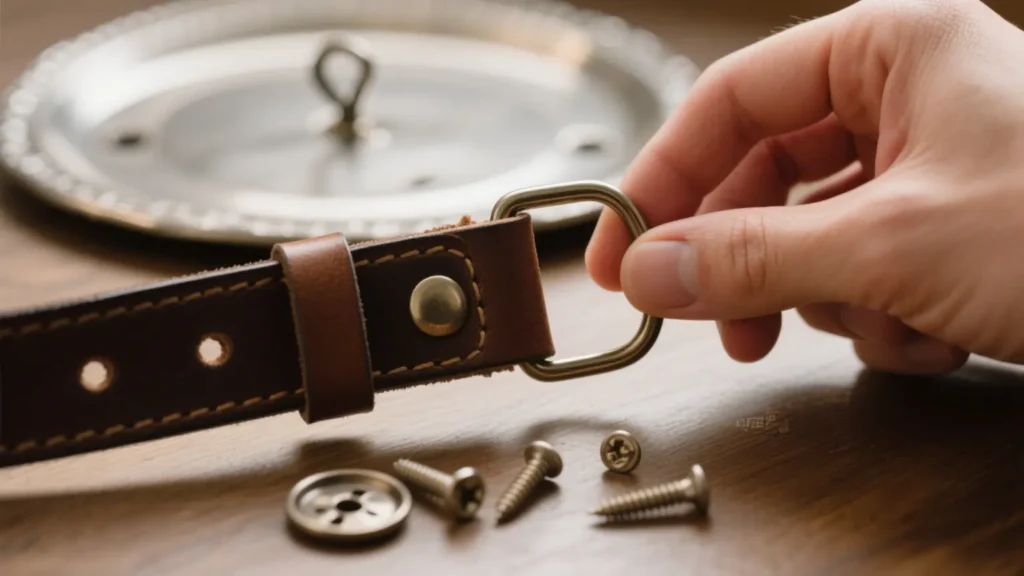How Do I Put a Belt Buckle on a Belt? Step-by-Step Attach & Swap Guide

If you’re asking “how do I put a belt buckle on a belt?”, you’re likely installing a buckle onto the strap (attach/swap), not just wearing it. This guide walks you through the four most common attachment systems—Western plate, prong with Chicago screws, ratchet (trim-to-fit), and clamp/flip-top—plus quick fixes when the buckle won’t sit straight or stay secure. We’ll keep it strictly about attaching to the strap (not sizing), so you can swap styles safely and get a clean, durable connection.
How do I put a belt buckle on a belt? Tools & prep
What you’ll need (not all are mandatory):
- Small flat/Phillips screwdriver (for Chicago screws or buckle frames)
- Optional blue threadlocker for Chicago screws (a dot, not a drop)
- Soft cloth or mat to protect leather/finish
- Scissors or a sharp blade (ratchet straps only, and only after test-fit)
- A marker or tape to mark your ideal tail length (ratchet)
Check your strap first
- Snap/Chicago screw end = designed for removable buckles (great for Western plates or prong buckles).
- Ratchet/webbing clamp = buckle captures the strap mechanically; usually no holes.
- Sewn-in/closed construction = not meant to be changed at home; consider a leather shop if you must modify.
Safety note: protect the strap face with a cloth while working; small metal burrs and overtightened screws can scar leather.
Put a Western plate buckle on a belt (snap-end straps)
What it is: A decorative plate with a hook/pin on the back that mates with a hole in your strap; the strap’s buckle end typically has snaps or Chicago screws so you can swap plates.
Steps
- Open the strap’s snap/Chicago screw at the buckle end; remove any small buckle that’s attached.
- Thread the strap through your pant loops (if you’re test-wearing), or work on a table.
- Line up the appropriate hole near the strap end with the hook on the back of the plate and hang it on.
- Fold the strap tail neatly behind/around the plate as designed, then close the snap or tighten the Chicago screws to lock it.
- Center the plate visually; if it drifts, switch to the adjacent hole for a tiny position shift.
Fixes when it won’t behave
- Tilts or rotates: ensure the hook is fully seated; move to a closer hole. A thin leather pad between plate and strap can reduce scuffing.
- Edge rubbing: check the plate’s back for rough spots; polish lightly or pad contact areas.
Put a prong buckle on a belt with Chicago screws
What it is: A classic frame + prong buckle that mounts to a strap using Chicago screws (two-piece posts). This is the clean, re-usable alternative to permanent rivets.
Steps
- Remove the old buckle and align the new frame with the strap’s attachment holes.
- Insert the female side of each Chicago screw from the face side where specified, seat the strap layers, then thread in the male side.
- Tighten until snug—do not over-torque. A tiny dab of blue threadlocker can help prevent loosening.
- Check alignment: the prong should move freely and sit centered over the hole row.
Fixes
- Screws back out over time: retighten after 24 hours; if needed, reapply a small amount of removable threadlocker.
- Squeaks or wiggle: confirm the strap layers are fully seated; check for a missing washer or debris in the hole.
For a clear pictorial walkthrough using Chicago screws, see this manufacturer guide on how to attach a belt buckle to a leather belt(external reference). Weaver Leather Supply
Put a ratchet buckle on a belt (trim-to-fit)
What it is: A hole-less strap with a tooth track on the back. The buckle clamps the strap and locks onto the track; release is via a lever.
Steps
- Test first. Insert the flat end of the strap into the buckle (teeth facing the clamp channel) and push until you hear clicks. Find a comfortable “click zone.”
- If the tail is obviously long, remove the strap at the buckle end and trim in tiny increments (about 6–7 mm / ¼”).
- Reinsert, test again, and repeat micro-trims until the tail length is just right.
- Confirm the release lever springs back and the buckle locks securely each time.
Fixes
- Slips or won’t lock: clean dust from the track and clamp channel; inspect for wear on the teeth.
- Over-trimmed: most brands offer replacement straps—this is why micro-trimming is essential.
Put a clamp / flip-top buckle on a canvas or webbing belt
What it is: A flip-top clamp with teeth or a pressure bar that bites into webbing or thin leather.
Steps
- Flip the clamp fully open so the teeth are clear.
- Insert the strap flat and straight (no twists).
- Close and press firmly so the teeth bite and hold.
- Tug lightly to confirm no slipping.
- To adjust, reopen, shift the strap, and clamp again.
Fixes
- Gradual slipping: clean the teeth; if webbing is very smooth, add a thin anti-slip patch to the strap’s inside.
- Stiff flip-top: dust and residue are common culprits—wipe with a dry cloth (avoid harsh solvents on plated parts).
Quick fixes if the buckle won’t stay on the belt
- Off-center look: move to the adjacent hole (plate/prong) or one click looser/tighter (ratchet).
- Tail flares out: route the tail through two keepers; consider a strap with a secondary keeper or end tab.
- Hardware loosens: re-seat Chicago screws and apply a tiny bit of removable threadlocker; ensure strap layers are flat.
- Clamp not biting: degrease lightly and re-clamp; extremely slick webbing may need a grippier clamp or an internal friction strip.
- Surface scuffs: protect the strap face with a cloth while working; deburr any sharp metal edges on the buckle.
When NOT to put a buckle on this belt
- The strap is sewn-in/closed with no removable attachments.
- The leather is cracked or delaminating near the buckle end.
- Hole spacing is incompatible with your Western plate hook.
- You’re unsure about structural integrity—see a leather shop for assessment.
FAQs — “How do I put a belt buckle on a belt?”
Can any strap take a Western plate buckle?
No. You need a strap with a removable buckle end (snaps/Chicago screws) and hole spacing that matches the plate’s rear hook.
Do I need threadlocker for Chicago screws?
Optional but helpful. Use a removable (blue) type and very sparingly—just enough to resist vibration.
How much can I trim a ratchet strap at once?
Only small increments (≈ 6–7 mm / ¼”) each time. Test, trim a hair, and repeat. Over-trimming can’t be undone.
Why does my clamp buckle keep slipping?
Teeth may be oily or worn, or the webbing is too slick. Clean the clamp, dry the webbing, and consider a thin anti-slip patch inside.
What to shop next?
- Explore Ratchet Belts for easy attach and micro-adjust comfort:
Ratchet Belts – Automatic Buckle Adjustable Belts - Explore Men’s Casual Belts:
Men’s Casual Belts – Everyday Belts for Jeans
Bottom line
Now you know how to put a belt buckle on a belt for every major system: hook and plate, prong with Chicago screws, ratchet track, and clamp. Work slowly, protect the leather surface, and—especially with ratchets—test before you trim. A tidy install means the buckle stays secure, sits centered, and looks intentional with your outfit.
